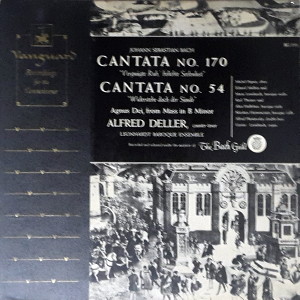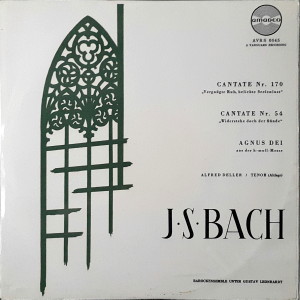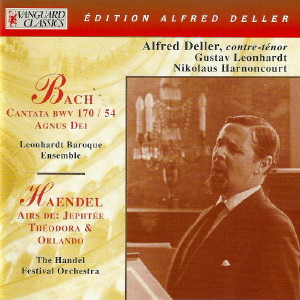 |
1 LP -
BG 550 - (p) 1954
|
 |
| 1 LP -
AVRS 6045 - (c) 19?? |
 |
| 1 CD -
08 5069 71 - (c) 1994 |
|
Johann Sebastian
Bach (1685-1750)
|
|
|
|
|
|
|
|
| Cantata
No. 170, "Vergnügte Ruh', beliebte
Seelenlust" |
|
|
|
| - Aria |
|
6' 48" |
A1 |
-
Recitative
|
|
1' 12"
|
A2 |
| - aria |
|
8' 14" |
A3 |
| - Recitative |
|
1' 00" |
A4 |
| - Aria |
|
5' 54" |
A5 |
| Agnus Dei, from Mass in B
Minor |
|
5' 29"
|
B1 |
Cantata No. 54,
"Widerstehe doch der Sünde"
|
|
|
|
| - Aria |
|
8' 59" |
B2 |
| - Recitative |
|
1' 08" |
B3 |
| - Aria |
|
3' 19" |
B4 |
|
|
|
|
| Alfred
Deller, counter-tenor |
|
Leonhardt Baroque
Ensemble / Gustav Leonhardt,
organo and director
|
|
| -
Michel Piguet, oboe |
|
| -
Eduard Melkus, baroque violin |
|
| -
Marie Leonhardt, baroque violin |
|
| -
Kurt Theiner, baroque viola |
|
| -
Alice Hoffelner, baroque viola |
|
| -
Nicolaus Harnoncourt, baroque
'cello |
|
| -
Alfred Planiawsky, baroque
double-bass |
|
|
Luogo e data
di registrazione
|
| Franciskanerkirche, Vienna
(Austria) - maggio 1954 |
|
Registrazione
live / studio
|
| studio |
Producer / Engineer
|
Seymour Solomon
|
Prima Edizione
CD
|
Vanguard Classics "Edition
Alfred Deller" - 08 5069 71 - (1 cd) -
59' 20" - (c) 1994 - ADD
|
Prima
Edizione LP
|
- Vanguard "The Bach Guild" -
BG 550 - (1 lp) - 42' 03" - (p) 1954
- Amadeo - AVRS 6045 - (1 lp) - 42' 03"
- (c) 19??
|
|
|
Notes on the program
|
|
The two Bach solo
cantatas on this record are given by
Spitta to the period 1727-1734 in
Leipzig, described by him as "the
richest and most fruitful years of
Bach's life." The small forces which
Bach employs in these works do not make
for any lessening of musical stature.
They have a chamber quality, and like
the chamber works of the great composers
of a century later, they reveal the more
deeply in strospective thinking of the
composer.
The cantatas illustrate vividly two
different sides of Bach's religious art;
the close attention to details of the
text, illustrating it woth musical
phrases and effects that have an almost
pictorial quality, which Albert
Schweitzer has annotated so
exhaustively; and the profound
intellectual qualities, displayed in
musical architecture, that Spitta so
exalts in the master.
In the Cantata no. 170. "Vergnügte Ruh"
the very opening, with its timbres of
oboe and strings, and tenderly rocking
rhythm, evoke a feeling of peace and
contentment of spirit, while the entry
of the voice adds a note of yearning,
and the aria is a beautiful working out
of this conflict. Of the following
explosive recitative, while we must
consider that its words were parte of
the religious tradition of the time, it
is hard not to find Bach also speaking
his mind in anger against the pettiness
and meanness which he found about him.
With the second aria, there is a
reversal of orchestral forces, with the
strings dropping to the bass, and the
organ, which had formerly played the continuo,
now rising to a brilliant obbligato
part. How effectively the organ phrases
illustrate "Wie jammern," the clamor
upon the sympathy of the good-hearted
man by the perverse and misguided
hearts! The aria proceeds as a clash
between the solo singer and the obbligato
organ, a remarkable psychological
portrayal of unrest and resolution. The
following recitative, which is
accompanied, is more peaceful. And in
the closing aria, Bach shows that having
made his own rules, he can break them.
The words at the opening tell of how
painful life appears to him, but the
music belies this, expressing a robust
joy in life, a victory over depressing
and tormenting thoughts. This music,
like all great music employing words or
story, while it embodies direct
illustrative material, uses these only
as elements in a musical structure, the
importance of which is that it captures
the deepest states of mind of the
composer. This cantata is a moving a
personal document as, in a different
style and period, a great Beethoven
piano sonata.
The score employed in this recording of
the Cantata No. 54, "Widerstehe doch,"
is not that of the Bach-Gesellschaft,
wich Friedrich Smend (Bach-Jahrbuch
1940-8) has shown to be based on a
rather carelessly made copy, but on a
later discovered manuscript in the
Bibliotheque Royale at Brussels. Io
opens with what Schweitzer describes as
"an alarming chord of the seventh... the
trembling of the basses and violas, and
the sighs of the violins, between them
give the movement a somewhat disturbing
effect. It is meant to depict the horror
of the curse upon sin that is threatened
in the text." The music, as it proceeds,
also portrays somewhat more tenderly,
the anguish of the heart. Smend
hasthrown additional light on this aria,
proving that it had originally been
written for the lost St. Mark's
Passion, on the text "Falsche
Welt, dein schmeichelnt Küssen... ."
Thus the music that Bach had originally
written on the theme of the kiss of
Judas, now becomes a more general
exhortation to withstand temptation and
sin. The recitative that follows begins,
in the words of arnold Schering, in "an
almost impersonally calm, declamatory
style," with a touch of the "visionary"
entering as the instrumental
accompaniment makes itself heard. In the
instrumental beginning of the final
aria, Schering finds that "the
chromatically descending quarter notes
represent sin... the sixteenth
continually circling about a single note
represent the devil, while the bass
stamps down in restless quarter notes."
With the entry of the singer a fugue
begins its soaring flight, with searing
dissonances, and with the appearance of
the word "davongemacht," "the events
develop at a breathless pace, and there
is no end to the surprises, including
overwhelmingly complicated canons, until
the composition is at an end."
The Agnus Dei from the
Mass in B minor, composed by Bach in
1733, was remodelled from the alto aria
in the Ascension oratori, "Ach bleibe
doch, mein liebstes Leben." As in the
case of the adapted aria in Cantata No.
54, it fits perfectly the text of its
new setting.
Notes and translation
by S. W. Bennett
|
|
About
The Performance and Recording
|
|
Typical of the esteem in
which Alfred Deller's artistry is held
by British critics is the Birmingham
Post's comment, "Mr. Deller, whose
wondrous voice graced both Purcell and
Danyel, is one of the supreme British
singers of our generation." His voice, a
counter-tenor, may be described as a
male alto, but of exceptional purity,
range and facility. It is the voice for
which Purcell, himself a counter-tenor,
wrote some of his finest airs, and is
also the timbre for which Bach conceived
the alto solos in his cantatas. The
qualities which have given Mr. Deller so
exalted a stature in musical circles in
both Great Britain and on the continent,
however, are not those of voice alone,
but include a studied mastery of the
phrasing of Renaissance and Baroque
music, and the genuine, if
unspectacular, virtuosity which the
music of this age calls for. Born in
1912 at Margate, Kent, Alfred Deller
made a reputation as a boy soprano in
works such as Handel's Messiah,
and during adolescence, found it natural
and easy to sing in the alto register.
His performances of music of the 16th
through the 18th centuries, have been
features of both numerous British
festivals and continental recitals. An
exclusive Vanguard-Bach Guild recording
artist, his first Bach Guild recording
was ELIZABETHAN AND JACOBEAN MUSIC
(BG-539) devoted largely to John
Dowland. Typical reviews were: "This
disc is one of the best of its type to
appear as yet on LP... the music is a
sheer delight from start to finish. Bach
Guild has recorded the recital in
impeccable fashion," The New Records.
"Offers music and performances that make
it an outstanding record," B. H. Haggin,
The Nation. This was followed by
MUSIC OF PURCELL, JENKINS AND LOCKE
(BG-547) and the present record of two
Bach Cantatas.
The Leonhardt Baroque Ensemble is made
up of outstanding performers in European
symphony orchestras, who have taken up,
as a labor of love, the Baroque
counterparts of their present-day
instruments. They are led by Gustav
Leonhardt, the distinguished Dutch
haspsichordist, Baroque scholar, and
Professor at the Academy in Vienna.
The recording is VANGUARD QUALITY
CONTROL, employing Ampex model 300
magnetic tape recorders in conjunction
with the Altec and Siemens-AKG C-12
condenser microphones, producing masters
which embody a frequency response
covering the entire range of human
hearing and embracing the full gamut of
orchestral, organ and vocal sonorities.
The location was the Franziskanerkirche
in Vienna, the organ of which dates from
1642.
|
|
Nikolaus
Harnoncourt (1929-2016)
|

|

|
|